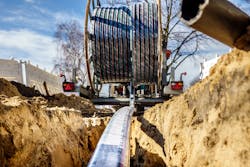Five Principles to Guide Us
In 2021, the nation committed to an extraordinary investment in fully and finally connecting every American home and business to high-speed Internet. The Infrastructure Investment and Jobs Act set in motion a timeline to achieve this ambitious goal by 2030.
We have now reached a critical phase of this work. The National Telecommunications and Information Administration is managing the $42.5 billion set aside for deployment and announced in June how these funds will be allocated among the states. Now, state broadband offices are in the make-or-break role of translating federal resources into specific projects. They are currently determining the criteria by which they will vet applicants and ultimately make their selections.
In other words, it’s crunch time for the work we all do together—state and federal policymakers, broadband providers, and all stakeholders—in converting the lofty goals set forth in the Broadband, Equity, Access, and Deployment (BEAD) program into connected reality throughout the country.
“Each state should ensure rights-of-way and permitting processes are as streamlined as possible. This includes coordination with other branches of government and easement holders like railroads. Indiana, for example, is pre-certifying communities as ‘broadband ready’—taking steps to reduce regulatory barriers, so they can hit the ground running once connectivity projects are approved.”
These five principles should guide our future work together.
Principle 1: Focus on Unserved and Underserved Locations
The Federal Communications Commission’s new national broadband map1 offers a granular view of where we need to fill deployment gaps. Through the BEAD challenge process, states have until the end of the year to weigh in on whether a location is unserved or underserved and therefore eligible for BEAD funding. Providers will have the same opportunity. In addition to delivering a more precise view of the work before us, this challenge process helps “de-dupe” the list of eligible locations—accounting for projects already underway and funded through other state or federal programs as well as projects advancing through the private investment of broadband providers. This attention to detail will help prevent the loss of funds to duplicative overbuilds, so every dollar can contribute to universal connectivity.
Principle 2: Prioritize Experience
State leaders should insist on partnering with providers who have a proven track record of success. In their selection and vetting process, state officials should ask: does the applicant have the experience, resources, technical know-how and round-the-clock capacity to ensure these networks are built, maintained, repaired, and secured for the long haul? No one understands better than network engineers that true, lasting universal connectivity is hardly a “set it and forget it” endeavor. The networks that BEAD monies fund must be sustainable in the long term.
Principle 3: Encourage Holistic, Scaled Builds
States should select proposals that cover the widest swath of underserved and unserved locations possible. Underserved areas (defined as those without access to 100/20 Mbps service) should be tackled alongside unserved areas (those without access to 25/3 Mbps service). Past programs favored narrow builds to unserved areas due primarily to budget constraints. Carrying that approach over to BEAD forfeits the program’s game-changing advantage—its sheer size and scale. Tackling unserved and underserved locations separately would require multiple truck rolls, repetitive or duplicative fiber and backhaul deployment, and other added effort—driving up costs and delaying connectivity.
Principle 4: Set Communities Up for Success
Each state should ensure rights-of-way and permitting processes are as streamlined as possible. This includes coordination with other branches of government and easement holders like railroads. Indiana, for example, is pre-certifying communities as “broadband ready”2—taking steps to reduce regulatory barriers, so they can hit the ground running once connectivity projects are approved.
Principle 5: Embrace Public-Private Partnerships
The challenges associated with rural broadband connectivity require an enduring and constructive commitment across the public and private sectors. We should take the opportunity presented by BEAD to shore up the foundation of our work together. Throughout the country, we see strong and mounting evidence of successful public-private partnerships, which allow each party to play to their respective strengths in pursuit of a shared connectivity objective. Among the many examples, Ritter Communications worked with the city of Stuttgart, Arkansas, to upgrade that community of roughly 8,000 people to an all-fiber network. In New England, Consolidated Communications is bringing fiber to 1.6 million homes and businesses by 2025. Both companies have been committed members of their communities for more than a century. Working constructively with state and local partners, they are demonstrating the drive and experience that defines our industry.
These partnerships work, and we’re seeing them replicated by innovative broadband providers and their community partners across the country. In sharp contrast, we’ve all witnessed the long and unfortunate history of municipalities attempting to build and manage their own networks. Partnerships where broadband providers and local officials each play to their strengths and experience consistently get the job done right, delivering lasting, reliable connectivity.
We Can Get the Big Things Done
As this work proceeds, USTelecom stands as a national resource3 and partner to state broadband offices and all stakeholders who share our determination to finish and sustain the work of connecting everyone to modern, high-speed broadband.
It’s true, the BEAD program represents a “once in a generation opportunity”. But it’s also important that we put this commitment in context. Our nation is walking the talk on its core values by putting up $42.5 billion in funding to connect the nation. Our industry—broadband providers—invest roughly $86 billion4 each year to do the same. Together, these resources can be transformative for our country.
BEAD represents our opportunity to collectively demonstrate that we can get the big things done. We do so for the long term by working together to get the details right today.
REFERENCES AND NOTES
1. FCC’s National Broadband Map, https://www.fcc.gov/BroadbandData
2. Indiana Broadband Ready, https://www.in.gov/indianabroadband/broadband-ready-communities-program/
3. USTelecom, Natural Resource, https://ustelecom.org/our-priorities/state-action-center/
4. USTelecom 2021 Broadband CAPEX Report, https://ustelecom.org/research/2021-broadband-capex-report/
About the Author
Jonathan Spalter
President and CEO, USTelecom – The Broadband Association
Jonathan Spalter is President and CEO of USTelecom – The Broadband Association. He has more than 30 years’ experience in public policy and leading innovative technology companies. For more information, visit www.ustelecom.org.
Follow Jonathan and USTelecom on social media:
https://twitter.com/Jspalter
https://twitter.com/USTelecom
https://www.linkedin.com/in/jonathanspalter/
https://www.linkedin.com/company/ustelecom-association/
https://www.facebook.com/ustelecom/

